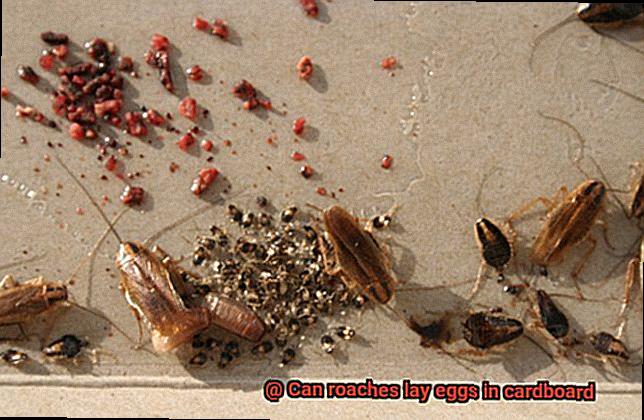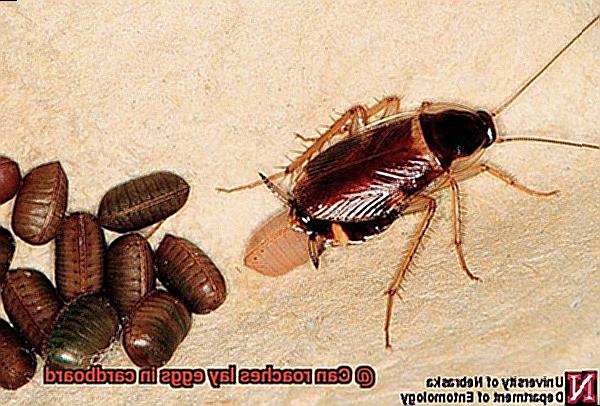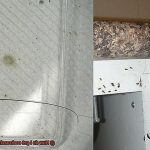Do you love keeping cardboard boxes in your home? Do you know that roaches are attracted to starch and paper products, which make cardboard boxes a perfect spot for them to lay their eggs? You might have seen these creepy crawlies scurrying around your cardboard boxes, but the question is – can they really lay eggs in there?
To get to the bottom of this question, we delved deep into our research. Our findings show that not only do roaches lay eggs in cardboard boxes, but they also consume the cardboard for its starch content. Shocking, right?
But why do roaches find cardboard so appealing? We’ll tell you all about it. Plus, we’ll give you tips on how to keep these pesky critters away from your precious cardboard boxes and what to do if you find any signs of a roach infestation.
Don’t let these unwelcome guests take over your home and spread diseases. Join us as we explore the fascinating world of roaches and cardboard – and learn how to keep your home roach-free.
What is a Roach?
Contents
Roaches, also known as cockroaches, are fascinating creatures that belong to the Blattodea order. They are one of the most common pests found in households, restaurants, and other places where food is prepared or stored. These insects have flat, oval-shaped bodies that are typically brown or black in color, making them easily recognizable with their long antennae and six legs.
Roaches are remarkable for their incredible ability to survive in a wide range of environments. They can adapt to both hot and cold temperatures and different types of food sources. These resilient pests are also known for their rapid reproduction rate, which makes them difficult to control once they infest a space.
There are several different species of roaches, but the most common ones found in households are the German cockroach, the American cockroach, and the Oriental cockroach. Each species has its own unique characteristics, such as size and coloration, but they all share similar behaviors and habits that make them undesirable house guests.
Roaches are nocturnal creatures, making them most active at night. During the day, they hide in dark and damp places such as cracks and crevices in walls and floors. Roaches are attracted to food sources such as crumbs, grease, and garbage. However, they have also been known to munch on paper products such as cardboard boxes.
In fact, cardboard is one of the preferred materials for roaches to lay their eggs in because it provides a warm and moist environment that is perfect for their offspring to thrive in. Roaches typically lay their eggs in clusters that can contain anywhere from 10 to 50 eggs depending on the species. These clusters are often hidden away in dark corners or crevices where they are less likely to be disturbed.

While roaches may be able to lay their eggs in cardboard boxes or other materials, there are steps you can take to prevent them from doing so and keep your home free from these unwanted pests. One of the most effective ways is to simply remove any cardboard boxes or other materials that may provide a suitable nesting site. Another option is to seal up any cracks or gaps in your home that may provide entry points for roaches.
If you do find yourself dealing with a roach infestation, there are several pest control products that can be used to eliminate the problem. However, it is important to use these products safely and according to the instructions provided by the manufacturer.
Can Roaches Lay Eggs in Cardboard?
Today we’re going to tackle the age-old question of whether or not roaches can lay eggs in cardboard boxes. Brace yourselves, because the answer is a resounding yes. But let’s explore the reasons why these pesky critters are so attracted to cardboard.
Firstly, roaches are survivors. They’re experts at adapting to different environments and reproducing quickly. And while they love feeding on scraps of food, they also seek out warm and moist spots to lay their eggs. That’s where cardboard comes in handy.
Cardboard boxes provide an ideal environment for roaches to lay their eggs. The material is porous, allowing them to nestle their eggs in the small spaces between the fibers. Plus, it’s dark and warm – two things that roaches adore.
Female roaches are prolific egg layers, producing anywhere from 10-50 eggs at once (depending on the species). These eggs are enclosed in a tough casing called an ootheca, which provides a safe haven for the developing embryos.
Once the eggs hatch, baby roaches will scamper out of the ootheca and start their journey towards adulthood. They’ll go through several molting stages before reaching maturity, all while feeding on whatever scraps they can find in your home.
But here’s the kicker: getting rid of cardboard boxes won’t necessarily solve your roach problem. These adaptable critters can lay their eggs in other hiding spots too, like under appliances or in crevices. That’s why it’s crucial to take a comprehensive approach when it comes to pest control.
Why Do Roaches Prefer Cardboard to Lay Their Eggs?
These pesky critters have a few reasons for their preference, and here’s why.
Firstly, cardboard offers a stable environment for roach offspring to develop. The material is porous and retains moisture, creating an ideal breeding ground for roaches. Additionally, the cardboard offers protection from predators and environmental factors that could harm the offspring.
Another reason why cardboard is such a popular choice for roaches is its accessibility. Cardboard can be found in many common areas of homes and businesses, making it easy for roaches to find a suitable place to lay their eggs without traveling far.
And let’s not forget the abundance of cardboard in urban environments. Roaches have adapted to thrive in areas where they can find food, water, and shelter easily. Since cardboard is often discarded and readily available in these types of environments, it makes for a convenient choice for roaches looking to lay their eggs.

So, what makes cardboard such an attractive option for roaches? It’s simple: it provides a stable environment, it’s easy to access, and it’s abundant in urban environments. By understanding this preference, homeowners and business owners can take preventative measures to reduce the likelihood of infestations.
However, it’s important to note that eliminating cardboard boxes won’t solve your roach problem entirely as they can lay their eggs in other hiding spots too. A comprehensive approach when it comes to pest control is crucial.
How Many Eggs Do Roaches Lay?
Roaches are infamous for being relentless breeders, and the number of eggs they can lay is dependent on their species. For instance, German cockroaches can lay up to 40 eggs at once and produce up to four generations each year, with each generation containing up to 40 eggs. This implies that one female German roach can give birth to a staggering 160 offspring every year. Conversely, the Oriental cockroach lays up to 16 eggs per batch, while the American cockroach can lay up to a whopping 90 eggs at once.
Temperature, humidity, and access to food and water can influence a roach’s egg-laying capabilities. Roaches prefer laying their eggs in areas where they can easily access food, water, and shelter for their young. Therefore, it’s important to keep your home clean and clutter-free to prevent roaches from breeding and thriving.
Although roaches may not lay their eggs directly in cardboard, they may use it as a hiding spot or a source of food. Cardboard is porous and absorbs moisture, making it the perfect spot for roaches to hide and breed. Properly disposing of cardboard boxes is key to keeping your home free of these pests.

Where Do Roaches Hide Their Egg Clusters?
Roaches are notorious for being prolific breeders, and they can lay up to 40 eggs at a time. So where do these sneaky pests hide their egg clusters? Well, they prefer dark, moist areas that are close to food sources and away from predators. Your kitchen, bathroom, and basement are all prime locations for them to lay their eggs. But cardboard boxes are one of the most attractive spots for roaches to make their cozy nesting place.
These slimy critters love cardboard boxes because the material provides them with a warm and moist environment that is perfect for their eggs to hatch and grow. So, it’s crucial to dispose of cardboard boxes properly and keep your home clean and clutter-free to prevent roaches from thriving.
Cleaning your home regularly is key to preventing a buildup of debris that attracts roaches. Regular cleaning tasks such as vacuuming, wiping surfaces, and taking out the trash can make a big difference. You should also inspect any items brought into your home to ensure that they are free from roaches and their egg clusters. Even paper bags, books, and furniture can provide these pesky critters with a hiding spot to lay their eggs.
Preventative Measures to Stop Roaches from Laying Eggs in Your Home
Roaches are notorious for being unsightly and posing a risk to your family’s health. These pests love to lay their eggs in dark, moist areas close to food sources, making your home the perfect breeding ground for them. However, there are various preventative measures you can take to stop roaches from laying eggs in your home.
Firstly, it’s essential to eliminate any potential egg-laying sites. Roaches are attracted to warm, dark, and humid areas, which makes cardboard boxes an ideal spot for them to lay eggs. Therefore, it’s crucial to remove all cardboard boxes from your home or store them in a dry and well-ventilated area. By doing so, you eliminate the possibility of roaches using them as a breeding ground.
Keeping your house clean and tidy is another effective way of preventing roaches from laying eggs. Regularly cleaning your home will help eliminate any food particles or crumbs that attract roaches. Additionally, keeping your home dry and well-ventilated will help prevent roaches from laying eggs in your home. Wiping down surfaces regularly, taking out the trash frequently, and cleaning up spills immediately are all simple yet effective ways of keeping roaches at bay.
Sealing any entry points is also crucial in preventing roaches from entering your home. Roaches can quickly enter through cracks or gaps in walls, floorboards, and windows. Sealing these entry points will help prevent roaches from gaining easy access to your home. Using caulk or weather-stripping to seal any gaps or cracks is a straightforward way of keeping roaches out.
Using insecticides designed specifically for roaches is another effective preventative measure. These products can be purchased at local hardware stores and come in various forms such as sprays, baits, and traps. It’s essential to follow the manufacturer’s instructions carefully when using these products and wear protective gear such as gloves and masks.
Finally, enlisting the services of a professional pest control company can be a game-changer in preventing roaches from laying eggs. Professional pest control companies have the knowledge and expertise to identify potential breeding sites and eliminate them effectively. They can also recommend preventative measures to prevent future infestations.
Conclusion
In conclusion, cardboard boxes are a prime target for roaches to lay their eggs. This is because roaches are attracted to starch and paper products, which are present in cardboard. Our research has shown that not only do roaches lay their eggs in cardboard, but they also consume it for its starch content.
Roaches find cardboard to be an ideal environment for their offspring to thrive in. The warm and moist conditions inside the box provide the perfect setting for them to lay their eggs in clusters of up to 50 depending on the species.
However, eliminating cardboard boxes alone won’t solve the problem entirely as these adaptable critters can lay their eggs in other hiding spots too. Therefore, taking a comprehensive approach when it comes to pest control is crucial.
Regularly cleaning your home, sealing entry points, using insecticides designed specifically for roaches, and enlisting professional pest control services are all effective preventative measures.
Roaches pose a significant risk to your family’s health and can quickly become an unsightly nuisance. By understanding why they prefer laying their eggs in cardboard boxes and taking preventative measures to stop them from doing so, you can keep your home roach-free and reduce the likelihood of infestations.






